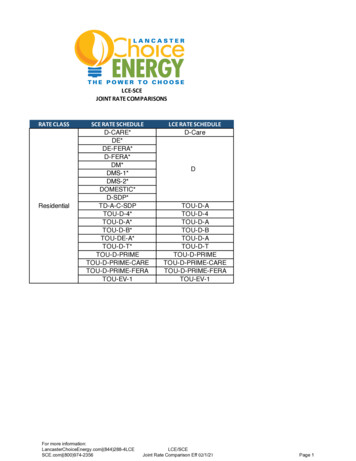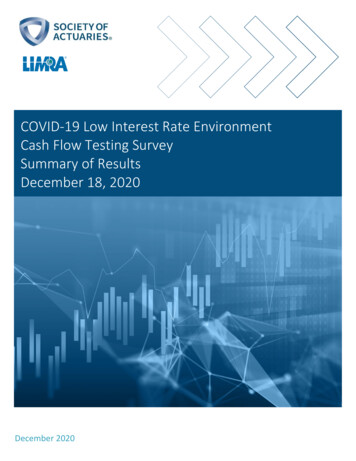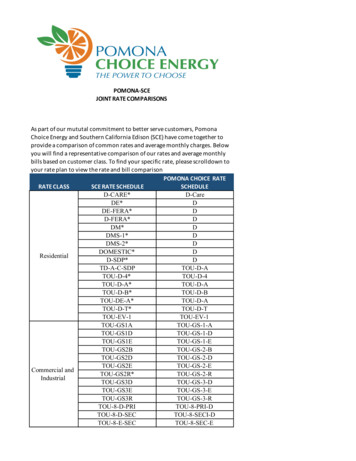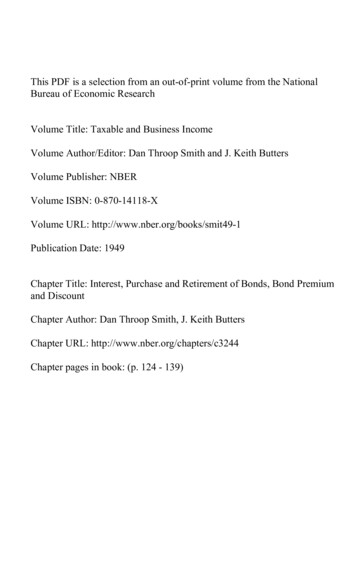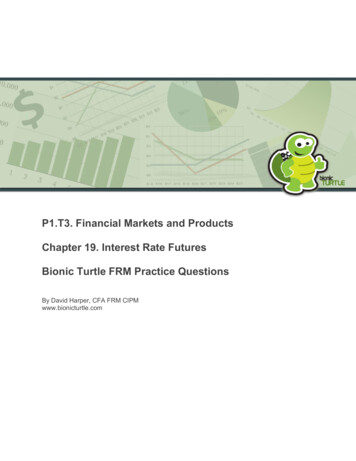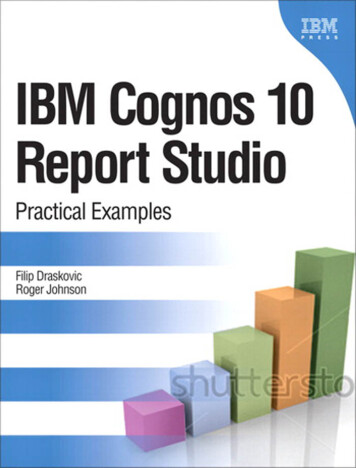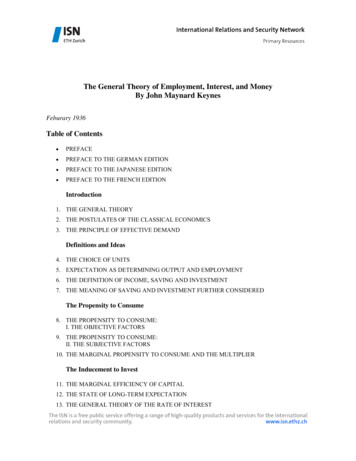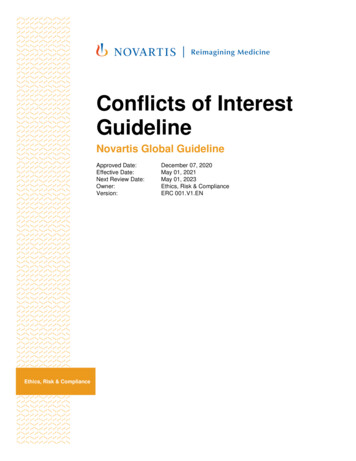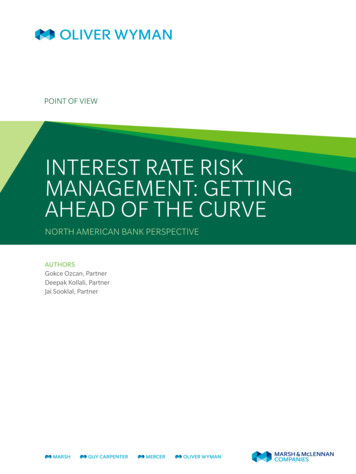
Transcription
POINT OF VIEWINTEREST RATE RISKMANAGEMENT: GETTINGAHEAD OF THE CURVENORTH AMERICAN BANK PERSPECTIVEAUTHORSGokce Ozcan, PartnerDeepak Kollali, PartnerJai Sooklal, Partner
EXECUTIVE SUMMARYManagement of Interest Rate Risk in the Banking Book (IRRBB) is starting to receive much moreattention, after a long period in which other regulatory and risk management issues dominated theheadlines. This shift results from: Market environment: Interest rates have been at historical lows for a long time, and started to rise inthe US, while interest rates in other geographies continue to decline to new record depths – includingnegative rates in several countries in Europe and Japan. The stark divergence in monetary policies,recent market volatility, and unknown customer behavior in response to rate changes combine tocreate significant uncertainties in risk taking, as well as added pressure on the bottom line. Regulatory pressures: The Basel Committee on Banking Supervision (BCBS) recently issuedStandards for IRRBB1 for the first time in more than a decade. The IRRBB standards introducea strengthened Pillar 2 approach (i.e. supervisory review process) and set out supervisoryexpectations for banks’ identification, measurement, monitoring and control of IRRBB. Moreover,US supervisory focus has sharpened on IRRBB as well as how it aligns with other regulatoryframeworks like Comprehensive Capital Analysis and Review (CCAR) and Liquidity Coverage Ratio(LCR), and additional emerging guidance such as Net Stable Funding Ratio (NSFR) and FundsTransfer Pricing, which will impact structural ALM position and IRRBB.These complex market and regulatory changes will need to be carefully managed, mostly by ageneration of practitioners who have not managed interest rate risk through similar challenges.This paper discusses the state of the industry and key enhancements banks need to focus on based onOliver Wyman’s extensive industry work and surveys of the North American banking industry run byOliver Wyman in 2011 and 20152, from which we can draw lessons on the evolution of IRRBB practices.Even though the focus is the North American banks, many of the same observations apply to global peers.Among the North American banks, we observe two themes that are particularly crucial for the banksto be ready for the increased regulatory scrutiny and changing market conditions: i) enhancement ofIRRBB analytics and integration with other key management decisions frameworks and ii) improvementof IRRBB governance by focusing on model risk management, limit frameworks and clear delineation ofroles and responsibilities. The IRRBB standards issued by the BCBS introduce a tighter outlier test andmuch more detailed disclosure requirements3, which will likely force banks to pay closer attention to theassumptions and management techniques used for IRRBB.Our expectation is that there will be continued and increased pressure by the regulators for banksto enhance IRRBB analytics and governance, broadly similar to the trends we have observed in theevolution of CCAR, liquidity management and resolution and recovery planning frameworks. In orderto be best positioned for the market and regulatory requirements, we urge banks to focus on thefollowing key tasks:1 See https://www.bis.org/bcbs/publ/d368.pdf, issued on April 21, 20162 Our 2015 IRRBB survey covered 20 North American banks with assets totaling 9.5 TN; our 2011 IRRBB survey 18 North American banks with assetstotaling 9.0 TN. A summary report for the 2011 survey titled “The State of Interest Rate Risk Management” is available on Oliver Wyman’s website.3 See page 6 of this paper for further details.Copyright 2016 Oliver Wyman
Develop and follow a comprehensive quantitative approach including: Net Interest Income (NII) and Economic Value of Equity (EVE) projections under multiplemacroeconomic scenarios over a multi-year horizon, incorporating historical analysis andsensitivity analysis. Customer behavior analysis such as deposit balances and re-pricing based on both statisticalmodels calibrated from historical data and “what if” scenarios that consider a wider range ofhypothetical scenarios. Align potential commonalities of the assumptions and engine of the IRRBB framework with keybalance sheet management frameworks such as capital and liquidity management. Apply a robust model risk management framework to all IRRBB models and assumptions. As part of strong governance around IRRBB, regularly review and calibrate interest rate risklimits and educate senior management and the Board on inherent strengths and weaknessesof metrics used. Clearly articulate the boundaries between 1st line and 2nd line responsibilities for effective andefficient execution.With these improvements, banks will have the capabilities for good decision-making in a cost-effectivemanner – which should be a high priority in light of the current regulatory and market changes andcontinued depressed bank profitability.3
STATE OF THE INDUSTRY AND CHALLENGES AHEADWith regulatory and market changes ahead, banks are facing a variety of challenges on which theyneed to focus to optimize the value and efficiency of IRRBB approaches. We observe two themesthat are particularly crucial for the banks to be ready for the increased scrutiny: i) enhancementof IRRBB analytics and integration with other decision frameworks and ii) improvement of overallIRRBB governance.Oliver Wyman’s extensive work on IRRBB and our recent surveys of the North American banking industryshow that banks are well aware of these challenges and they are looking to further build out theircapabilities. Comparisons between our 2011 and 2015 surveys enable us to observe the evolution of theindustry post-crisis. Select exhibits from our 2015 survey are shown through the remainder of this paperto illustrate leading practices in the industry.ENHANCEMENT OF IRRBB ANALYTICS AND INTEGRATION WITHOTHER KEY MANAGEMENT DECISION FRAMEWORKSOne of the key trends we observe at the best practice banks is that they continuously invest indevelopment and improvement of IRRBB analytics. These improvements cover more granular androbust modeling of assets and liabilities for IRRBB purposes, deployment of more efficient enginesthat are capable of running multiple scenarios quickly, better use of data for parameter calibration,and continuous review and refinement of modeling approaches and assumptions.Moreover, best practice institutions develop and follow a flexible model-driven approach thatincorporates historical analysis, sensitivity analysis, and NII and EVE projections under manyscenarios over a multi-year time horizon. Investing in these capabilities allows banks to bettermanage the complexity and uncertainty of the markets, and meet core regulatory expectations.The introduction of the enhanced disclosure requirements and other requirements laid out in theBasel Committee’s Standards for IRRBB will inevitably heighten scrutiny around methodologies andunderlying assumptions.According to our survey, roughly two thirds of the participants manage their earnings and value strategyto a variety of scenarios including parallel shocks, steepening/flattening, ramps and historical ratehikes/cuts as well as CCAR scenarios. More advanced institutions consider the impact of credibleemerging scenarios (e.g. Euro-break up, bullish dollar curve) to understand effects and identifymanagement actions. The vast majority of the participants indicated that they will continue to focus onadvancing IRRBB analytics – a sign that best practice is continuously improving.Copyright 2016 Oliver Wyman
In parallel to enhancing IRRBB analytics, best practice banks are actively working to integrate IRRBBanalytics with related key management frameworks as much as possible. Recently, exacerbatedby various regulatory pushes, a complex web of different but related analytical frameworks have beendeveloped at most banks. As various pieces of this puzzle have neared maturity individually, the pushnow is to ensure conceptual consistency, direct integration where possible, more efficiencies, andultimately better decision-making.More specifically, the IRRBB measurement and management framework shares data, processes, systemsand methodologies with many key management applications, as summarized in the Exhibit 1.Exhibit 1: Balance sheet management framework overlapsOVERLAP WITH IRRBB MANAGEMENTCCARNet interest income calculations, baseline balance and rate projections, baseline valueprojections, systems and governance framework.Balance Sheet and P&L optimizationInterest income and interest expense expectations, expectations on non-maturitydeposits and behavioral options, strategic decisions on asset-liability mismatch.FTP framework and profitability/performance measurementConsistency of behavioral assumptions, deposit maturity and re-pricingcharacterization, mismatch unit mandate and allocation of mismatch benefits.LCR and other liquidity frameworksAssumptions around stressed outflows, notably related to deposit run-off, collateral,and off-balance sheet behavior.The applications above constitute a web of partially overlapping frameworks. It is important tobridge the gaps between these applications for optimal balance sheet positioning and good decisionmaking. Moreover, given the increased demand on analytics and reporting, consistency among theseframeworks is needed for increased efficiency, shorter turnaround times, and to avoid potentiallycontradictory outcomes. In particular, leveraging consistent data and systems infrastructure acrossapplications can lead to major cost efficiencies. We expect increased regulatory scrutiny will causebanks to improve robustness of their analytics, data and consistency across these related frameworks.This expected focus on IRRBB analytics and the heightened expectations will be similar to theevolution of most recent regulatory focus areas.One prime example of this framework consistency and quantitative robustness challenge is depositcharacterization underlying IRRBB analysis. The objective of deposit characterization is to identifyexpected behavior of indeterminate deposits along multiple dimensions: i) determination of the coreportion that will stay with the bank for the longer run, ii) pricing sensitivity of deposits to changinginterest rates and iii) expected maturity of deposit accounts. This is critical as deposits constitutethe main form of funding for most banks. The industry has not yet fully figured out the alignment ofIRRBB deposit characterization with LCR requirements or Pre-Provision Net Revenue (PPNR) modelingunder CCAR, as seen in the survey results in Exhibit 2; however best practice banks are investing inthese capabilities.5
Exhibit 2: Alignment of IRRBB deposit characterization with LCR and CCARHOW ARE YOU APPROACHING THEALIGNMENT OF INTERNAL LIABILITYCHARACTERIZATION AND LCR REQUIREMENTS?HOW INTEGRATED IS YOUR NIISENSITIVITY ANALYSIS WITH PPNRMODELING FOR CCAR?PARTICIPANTS COULD SELECT MORE THAN ONE OPTIONDifferences in theseframeworks are wellunderstood, but not fullyintegrated or reconciledNII sensitivity and PPNRmodeling developed inparallel, with nointegration yetPost integration of internalliability characterizationand LCR frameworksin downstreamprofitability/FTPframeworksNII sensitivity and PPNRmodeling developedin parallel, withfull reconciliationIntegrated frameworkfor internal liabilityCharacterization and LCRFully integratedapproach betweenNII sensitivityand PPNRNot considering,frameworks areindependentOther ornot applicable0%20% 40% 60% 80% 100%0%20% 40% 60% 80% 100%Source: Oliver Wyman analysis.In addition to the above challenges, there is a growing concern among practitioners that the existingdeposit characterization approach might not be good enough as we enter a rising rate environmentfor the first time in nearly a decade. Most of the existing deposit models have been calibrated usingdata from near-zero rate environments where bank balance sheets have been flooded with deposits.It is anybody’s guess as to how quickly “hot money” will leave bank balance sheets for more lucrativeinvestment opportunities, in particular in light of diverging monetary policies. We recommend welldesigned “what if” scenario analysis as an integral part of IRRBB discussions.Copyright 2016 Oliver Wyman
BCBS STANDARDS FOR IRRBBPROPOSED REGULATORY CHANGES TURN UP THE HEATON IRRBB MANAGEMENTIn April 2016, BCBS issued Standards for Interest Rate Risk in the Banking Book. The standards, issuedfor the first time in more than a decade, introduced a strengthened Pillar 2 approach and set outsupervisory expectations for banks’ identification, measurement, monitoring and control of IRRBB aswell as its supervision.The revised standards, which were published for consultation in June 2015, are expected to be implementedby 2018. The standards reflect many elements of the feedback from the industry to the 2015 ConsultativeDocument; in particular: i) the Pillar 1 approach is out of consideration and enhanced Pillar 2 approach is thesuggested approach for IRRBB supervision and ii) banks have the option to use their internal measurementsystems to calculate the sensitivity metrics. However, supervisors have an option to mandate banks to followthe standardized framework for IRRBB disclosures, which includes certain punitive components.The Standards for IRRBB cover the enhanced requirements over 12 principles: Nine principles are directedto banks including identification of IRRBB, sound methodologies, risk appetite and limits, internal reporting,external disclosures, data, controls and model risk management. Three principles are directed to supervisors,and focus on review of soundness of banks’ IRRBB management, collaboration among supervisors andidentification of outlier banks. Key highlights of the standards include: IRRBB management process: Greater guidance has been provided on the expectations for abank’s IRRBB management process, in particular the development of shock and stress scenarios tobe applied to the measurement of IRRBB and the key behavioral and modeling assumptions whichbanks should consider in their measurement of IRRBB. The guidance notes the importance of CreditSpread Risk in the Banking Book (CSRBB) and urges banks to properly monitor and assess CSRBB;however, the standards focus mainly on IRRBB. Governance: Models used to measure IRRBB should be comprehensive and covered by governanceprocesses for model risk management, including a validation function that is independent of thedevelopment process. Measurement outcomes of IRRBB and hedging strategies should be reportedto the governing body or its delegates on a regular basis. Moreover, banks must implement policylimits that target maintaining IRRBB exposures consistent with their risk appetite. Enhanced disclosure requirements: The disclosure requirements have been standardized andenhanced to promote greater consistency, transparency and comparability in the measurementand management of IRRBB. Banks must disclose, among other requirements, the impact of interestrate shocks on change in economic value of equity (ΔEVE) and change in net interest income (ΔNII),computed based on a set of prescribed interest rate shock scenarios. Supervisory review: The supervisory review process has been updated to elaborate on the factorswhich supervisors should consider when assessing the banks’ level and management of IRRBBexposures. Supervisors could also mandate the banks under their respective jurisdictions to followthe standardized framework for IRRBB (e.g. if they find that the bank’s internal measurementsystem does not adequately capture IRRBB). The standardized framework has been updated toenhance risk capture. Outlier test: The threshold for the identification of an “outlier bank” has also been tightened; theoutlier test(s) applied by supervisors should at least include comparison of the bank’s ΔEVE with15% of its Tier 1 capital, under a set of prescribed interest rate shock scenarios.7
ENHANCEMENT OF IRRBB GOVERNANCEA second key trend we observe is a heightened focus from regulators and practitioners on governanceof IRRBB measurement and management processes. Particular attention is being put toward enhancingmodel risk management, limit setting and clearly delineating roles and responsibilities between first andsecond lines of defense.Model risk management has been a key focus area for the industry for the past few years, and weexpect IRRBB models to be held to this elevated standard as indicated by the Standards for IRRBB.Inherently, there are numerous assumptions underlying IRRBB analysis, and without appropriatetransparency and governance, the usefulness of the analysis can be compromised (or in extreme cases,become misleading). Examples of critical assumptions underpinning IRRBB measures include itemssuch as baseline interest rate expectations, balance sheet forecasts (and sensitivity to interest ratescenarios), deposit duration, prepayment assumptions, and discount curve construction.With increasing focus on model risk management and reporting across all key frameworks, mostinstitutions have significantly enhanced their governance around IRRBB practices. This includesheightened focus on assumptions management and validation, more sensitivity analysis, and betterunderstanding of model uncertainties.We expect that the industry will continue to enhance their model risk management practices and payparticular attention to the review, validation and update of the approaches and assumptions.Exhibit 3: IRRBB model and assumption governance best practices86%81%67%Systematically track and document allassumptions and test sensitivity for allmajor assumptions periodicallyAnalyze impact of major changes toIRRBB model assumptions; requireapproval of change by committee bodyfor major assumptionsBacktest IRRBB models and independentlyvalidate IRRBB models on an annual basis,with detailed report and remediation stepscirculated to managementLimit setting and monitoring is another key component of a well-defined governance framework. Asevidenced by the comparisons over time of Oliver Wyman surveys on IRRBB management practices,Board level limits used to manage IRRBB have been changing in line with the stream of regulatoryrules and their impact on IRRBB management. Traditionally, NII sensitivity or value (e.g. EVE or DV01)sensitivity to interest rate shocks have been the main limits used by Boards (or Board sub-committees).However, recently, many banks have introduced limits on sensitivity of Other Comprehensive Income(OCI) or Basel III regulatory capital ratios to interest rate shocks to be tracked alongside the traditionallimits. This is reflective of the evolving regulatory landscape with the implementation of Basel III anddirect capital implications of interest rate and credit spread changes in the Available-For-Sale (AFS)book, as well as larger securities portfolios across the industry due to liquidity regulations whichincrease the materiality of the issue.Copyright 2016 Oliver Wyman
Furthermore, there is increasing pressure on Boards to see a broader range of IRRBB metrics and limits,such as key rate durations and convexity, given the acknowledgment that all measures have someinherent limitations.Exhibit 4: Limits used for monitoring IRRBB by the Board (or Board sub-committee)94% 95%88%90%45%45%35%2015IRRBBSurvey0%NII sensitivity tointerest rate shocksValue (EVE or DV01)sensitivity to interestrate shocksAFS Mark-to-Market/OCIsensitivity or regulatory capitalratio sensitivity to interestrate shocks2011IRRBBSurveyOther (e.g. duration,convexity,Economic Capital)Source: Oliver Wyman analysis.With the changes in the regulatory requirements for IRRBB, primary metrics and limits will likelycontinue to evolve. Other best practices include the following in addition to continuous review ofmetrics and limits used by the sen
CCAR Net interest income calculations, baseline balance and rate projections, baseline value projections, systems and governance framework. . In April 2016, BCBS issued Standards for Interest Rate Risk in the Banking Book. The standards, issued for the first time in more than a decade, in
